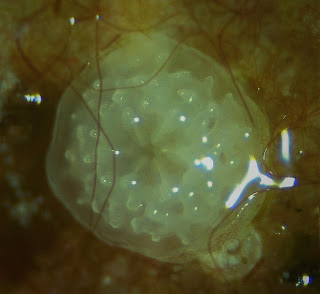All those recruits
 |
| A coral recruit on one of my tiles. |
Here's the problem, though: baby corals don't come with nametags. They all kind of look alike, too. The best way to identify young coral recruits is by sequencing their DNA. My intern, Maikani, had identified all the baby corals from our previous trips earlier this year. Sequencing the 2023 samples was the last piece of the puzzle.
This week, I have spent a lot of time with those samples. The DNA extraction itself is pretty straightforward: you incubate the tissue overnight with a buffer, crank up the heat for 10 minutes the next morning, then centrifuge the tube and save the liquid from the top. Now that we've refined our methods, amplifying the target sequence is pretty straightforward, too. Honestly, the most difficult step in the whole process is getting the samples out of the tubes.
Don't laugh when I say that. We preserve the coral babies in ethanol, but ethanol inhibits a lot of the downstream chemical reactions that you need for DNA sequencing. Plus, the corals themselves are tiny. One by one, I pulled the little babies out of their tubes, deposited them in a petri dish under my microscope, rinsed them off, and carefully transferred them into their new tubes for the incubation. It was painstaking.
But my work has paid off. All but a few samples had great amplification, so I should get reliable sequences. I'm really excited to see the results!
Comments
Post a Comment